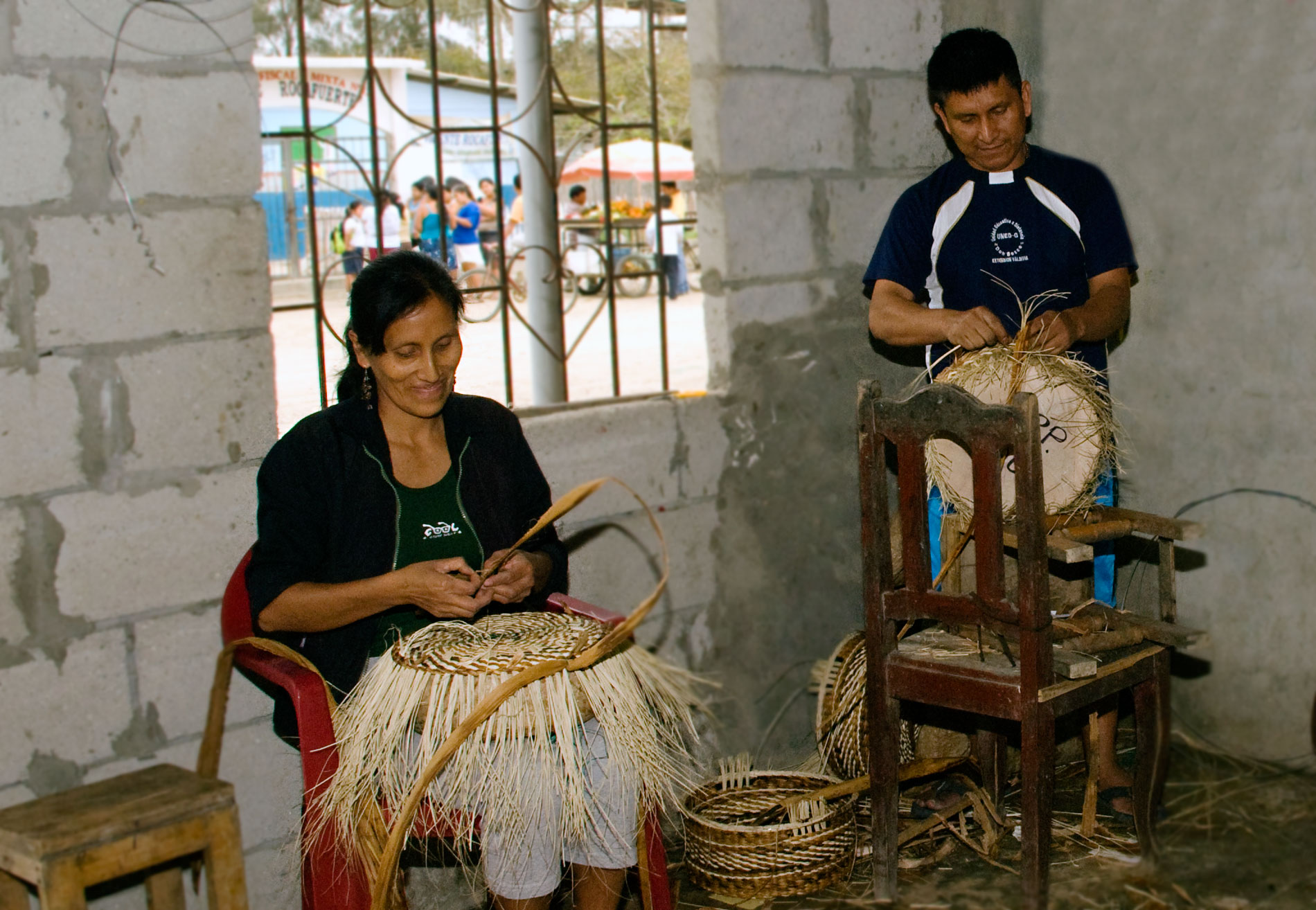Description
La materia prima para el trabajo en fibras vegetales es variada y extensa en el Ecuador y depende de la zona en la que viven los artesanos (Costa, Sierra, Oriente). Las fibras pueden ser rígidas, semirrígidas o suaves; las más trabajadas son la duda, carrizo, totora, palma, paja de cerro, paja toquilla, mimbre, zapán, tallo de trigo, chocolatillo, zuro y bejuco.
Las técnicas básicas consisten en entrelazar, enrollar, trenzar y tejer manualmente estos elementos (varas, hierbas o pajas) para construir objetos planos y volumétricos. Algunas fibras son teñidas con tintes naturales o anilinas y otras se dejan al natural.
En Ecuador se hace cestería de diferentes tamaños y formas: cestos, canastos, moisés[1], pañaleras, basureros. Estos productos se crean en las provincias de Azuay, Imbabura, Bolívar, Tungurahua, Cotopaxi, Manabí, Esmeraldas, Santa Elena, El Oro y en toda la Amazonía. En la mayoría de las provincias del país se realizan objetos utilitarios e individuales como portavasos, esteras[2], esterillas, petates, carteras, sopladores, llaveros, muebles, carteras, entre otros.
La cordelería es otra labor artesanal, con esta técnica se producen cuerdas, sogas e hilos con los que se realizan ataduras o amarres. Estos objetos artesanales se fabrican en las provincias de Carchi, Imbabura, Cañar, Azuay y Loja. En Cotopaxi, Tungurahua, Imbabura y Chimborazo las comunidades indígenas tejen shigras o bolsos de cabuya. Por otro lado, está la sombrerería, subrama que se trabaja en las provincias de Manabí, Santa Elena, Esmeraldas, Azuay, Cañar y Morona Santiago.
Es importante mencionar el material elaborado por las nacionalidades indígenas de la Amazonía a partir de una corteza conocida como llanchama[3]. Esta corteza, después de ser golpeada y lavada, adquiere una textura similar a una tela gruesa que se le tiñe o decora para vestimenta.
[1] Pequeña cuna tradicional para bebés que posteriormente es forrada con esponja y tela.
[2] Especie de alfombras tejidas de fibras que se emplean para colocar en el piso como soporte.
[3] Corteza fibrosa interior de árboles de las familias de las moráceas y de las palmáceas.
English
Products from vegetable fibres
The raw material for working with vegetable fibres is varied and extensive in Ecuador and depends on the area in which the artisans live (coast, highlands, east). The fibres can be rigid, semi-rigid or soft; the most commonly used are duda, carrizo, totora, palm, mountain straw, toquilla straw, wicker, zapán, wheat stalk, chocolatillo, zuro and bejuco. The basic techniques consist of intertwining, winding, braiding and weaving these elements (sticks, grasses or straws) by hand to construct flat and volumetric objects. Some fibres are dyed with natural dyes or aniline dyes and others are left natural.
In Ecuador, basketry is made in different sizes and shapes: baskets, baskets, bassinets, nappy baskets, and waste baskets. These products are made in the provinces of Azuay, Imbabura, Bolívar, Tungurahua, Cotopaxi, Manabí, Esmeraldas, Santa Elena, El Oro and throughout the Amazon. In most of the country’s provinces, utilitarian and individual objects are made, such as cup holders, mats, mats, mats, mats, wallets, blowers, key rings, furniture, and wallets, among others.
Cordage is another handicraft, with this technique ropes, ropes and threads are produced to make ties or moorings. These handicrafts are made in the provinces of Carchi, Imbabura, Cañar, Azuay and Loja. In Cotopaxi, Tungurahua, Imbabura and Chimborazo, the Indigenous communities weave ‘shigras’ or cabuya bags. On the other hand, there is hat weaving, a sub-branch that is worked in the provinces of Manabí, Santa Elena, Esmeraldas, Azuay, Cañar and Morona Santiago.
It is important to mention the material made by the indigenous nationalities of the Amazon from a bark known as “llanchama”. This bark, after being beaten and washed, acquires a texture similar to a coarse cloth that is dyed or decorated for clothing.



Reviews
There are no reviews yet.